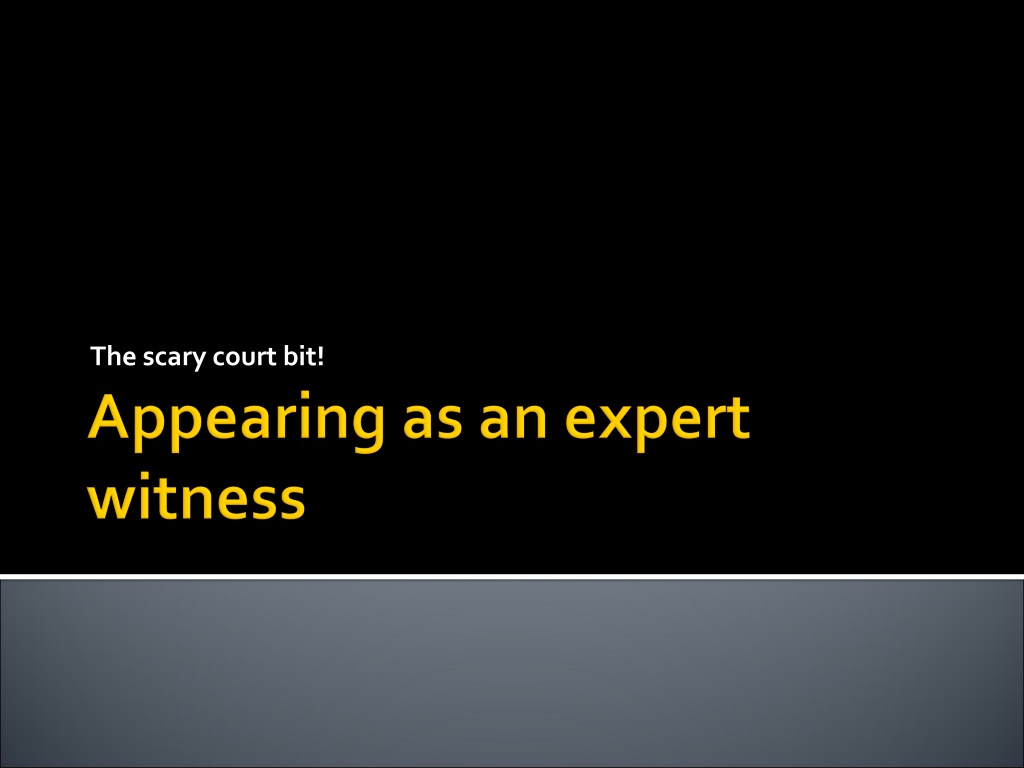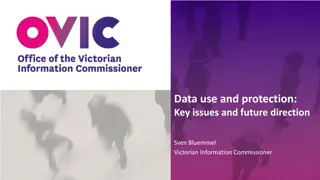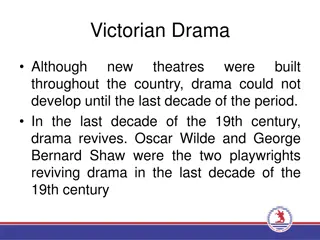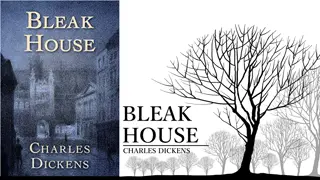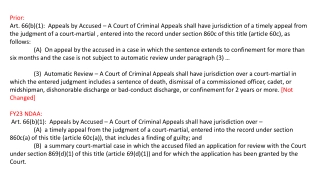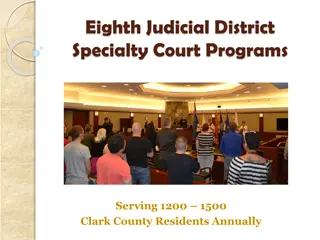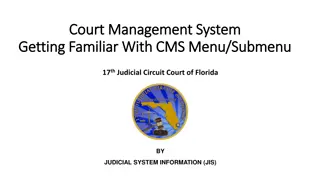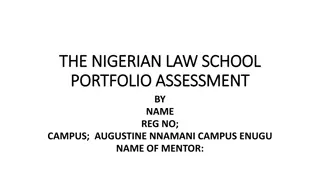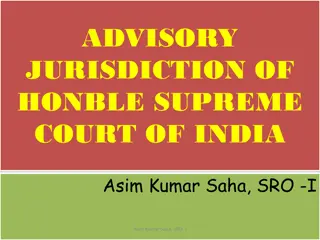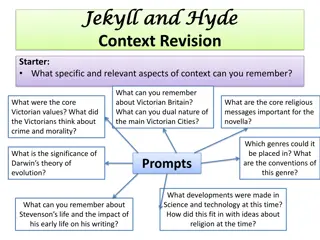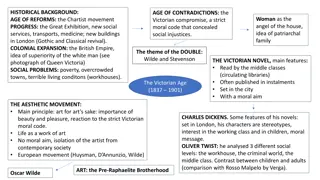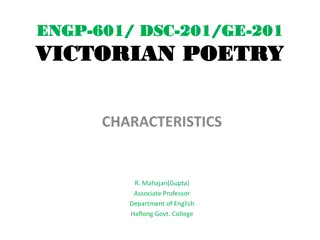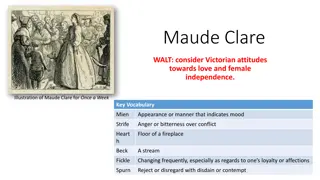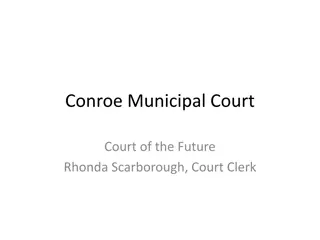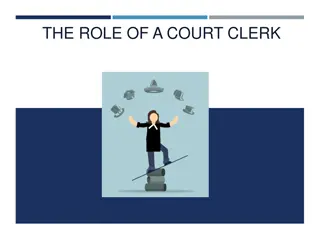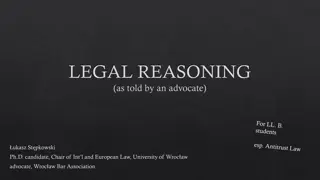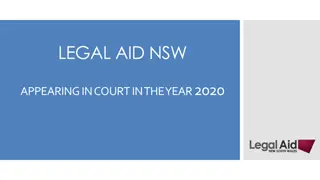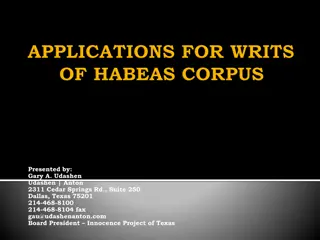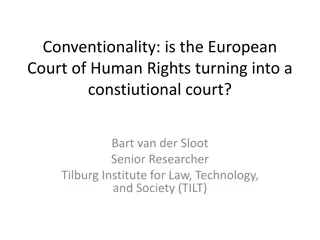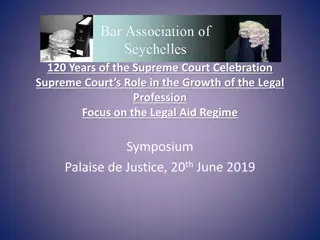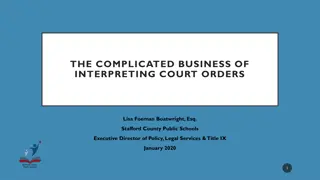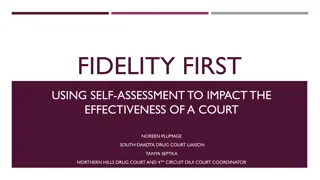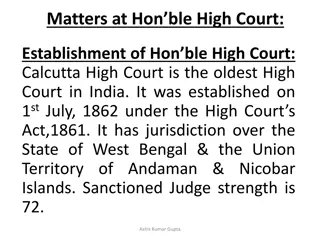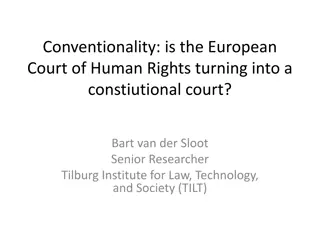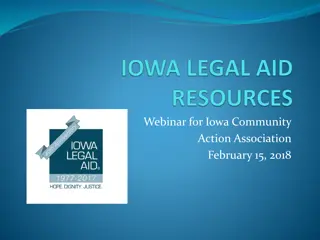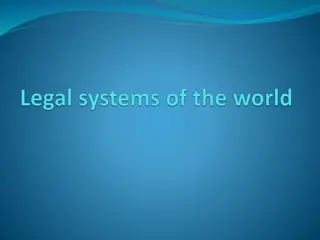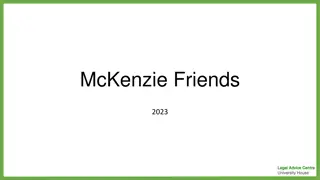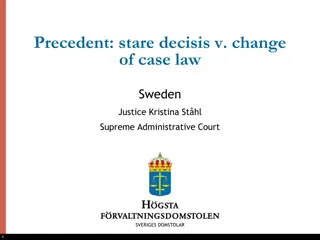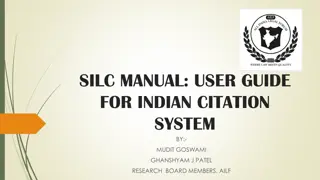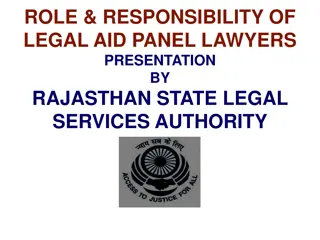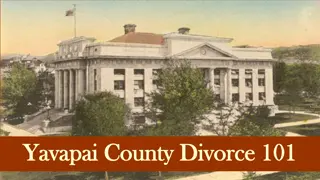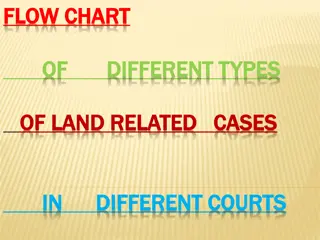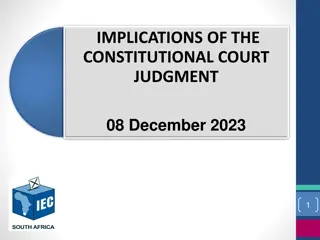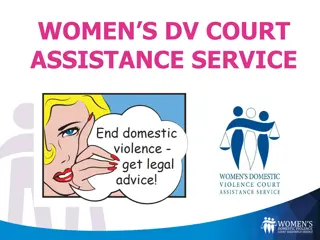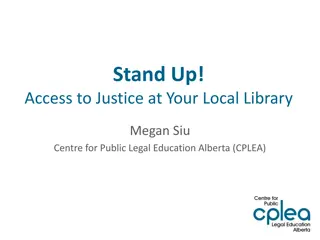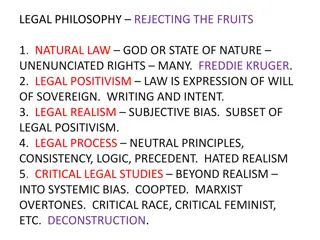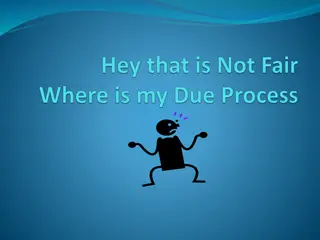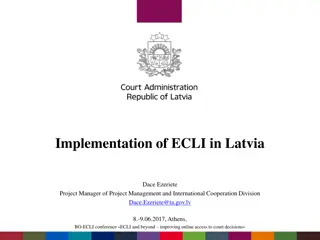Understanding the Victorian Court System and Legal Framework
Delve into the history, structure, and processes of the Victorian court system, exploring the foundations of law and social cohesion. Discover the evolution of legal constructs, the application of scientific methods, and the diverse court systems across different regions.
Download Presentation

Please find below an Image/Link to download the presentation.
The content on the website is provided AS IS for your information and personal use only. It may not be sold, licensed, or shared on other websites without obtaining consent from the author. Download presentation by click this link. If you encounter any issues during the download, it is possible that the publisher has removed the file from their server.
E N D
Presentation Transcript
Background definitions, terms History and structure of the Victorian court system Court processes who, where, what, how? Worries, concerns, questions experience?
Sets of rules governing units/societies Social cohesion enhances survival of social groups Law is an artificial construct All people have an innate sense of right and wrong BUT one person s may be different to another s Law = set of rules that capture the social norm & regulate individuals in society Law = assessment against a set of rules NOT an assessment of right and wrong Everybody is equal and it should be hard to remove a person s liberty .
Law is an artificial construct All people have an innate sense of right and wrong BUT one person s may be different to another s Law = set of rules that capture the social norm & regulate individuals in society Law = assessment against a set of rules NOT an assessment of right and wrong Everybody is equal and it should be hard to remove a person s liberty .
Used in courts of law Fit for legal argument Relating to or denoting the application of scientific methods and techniques to the investigation of crime
Shared with the English system Transported here with the convicts Terra Nullis nothing here indigenous people s systems not recognised Initially an extension of the King s jurisdiction medieval England. Matters heard by the King or delegates Kings decision; Judge made Law (statute or Acts) Development of precedent cases should be decided in the same way as previous cases The law is found not made through argument and persuasion Basis of current criminal law
Adversarial Australia, UK Inquisitorial European Religious -Islamic countries Customary/traditional Koori courts Each system consists of criminal (protection of society guilty or innocent) and civil law (disputes between citizens, protection of an individual financial compensation)
Matters solved by trial by ordeal (criminal cases) or trial by battle (non-criminal cases) Trial by ordeal ended 1215, trial by battle ended 1819 Development of local jury decided who was telling the truth Trial by peers
INQUISITORIAL ADVERSARIAL Decider hears all the arguments each party calls witnesses Decision made by lay jury Strict rules of evidence Police direct Ix and prepare brief Prosecutor presents case on behalf of the state act fairly, defence challenges Must be beyond reasonable doubt (criminal) or balance of probability (civil) Decider (magistrate/judge) comes to a conclusion Facts in one hand, legislation in the other Magistrate leads Ix Any type of evidence accepted Judge according to soul and conscience experience/intuition In Australia criminal and civil systems are adversarial Coroners courts, Royal commissions and tribunals use inquisitorial system
Court of appeal and trial court Treason, murder, high level civil Supreme court of Victoria (court of appeal for county/family court) Both original cases and appeals Principal trial court Indictable criminal cases except treason and murder/murder-related Serious civil offences County court (court of appeal for magistrates court) Magistrates court (State coroners office, PERIN, victims of crime assistance tribunal and family/children s court, drug court, koori court, family violence court) > 90% of court matters All summary and most indictable (not robbery, rape, murder) Civil matters up to $100,000 Family law and work injury
477 Little Lonsdale Street - also sit at magistrates court CBD or country Matters concerning children under 18 years Appeals made to the supreme court 2 divisions; criminal and family The Family Division hears: applications relating to the protection and care of children and young persons at risk applications for intervention orders The Children's Koori Court (Criminal Division) hears: matters relating to criminal offending by Koori children/young persons, other than sexual offences. The Criminal Division hears: matters relating to criminal offending by children and young persons.
What evidence is admissible, how it should be heard All relevant evidence is admissible in court Example of adjectival law the laws that govern the way in which legal processes are carried out Underpins the adversarial system
Placed on prosecution Any/reasonable doubt not guilty If defence have to prove a fact (rare) balance of probability Not NO doubt Must be hard to remove liberty
Relevance generally pertinent to the case Admissibility relevant to the facts and not excluded by a rule of evidence (fairness), overly prejudicial with little probative value Judge decides Weight degree of consideration that should be given to that piece of evidence. Jury decides Judicial notice/Presumption accept facts without hearing evidence taken as read , matters of common knowledge eg presumption of death Burden of proof carried by the prosecution Standard of proof balance of probability (civil) and beyond reasonable doubt (criminal)
Same set of rules apply If child is competent they are compellable Must be competent to swear the oath Not a matter of age but of understanding Can give unsworn evidence but hard to convict on that evidence Unsworn evidence of one child cannot corroborate unsworn evidence of another
Witnesses are the lifeblood of the courts Who can give evidence? Competence legally capable Compellability can be compelled to give evidence Usually the same BUT with doctors they can be competent to give evidence of the facts but may not be competent to give an opinion about those facts NOT legally competent
Expert is privileged Draws inferences from those facts Can therefore give opinions, interpretations and draw conclusions Based on qualifications or training No property in an expert witness either party OPINION EVIDENCE Lay person gives evidence based on facts Determined by their 5 senses Story of what they have said, done, heard
A field of specialised knowledge (identifiable training, study or experience) Opinion wholly/substantially based on witnesses expert knowledge Demonstration of scientific basis for opinion Party calling must qualify before the courts examination in chief Matter for court not jury jury may decide weight May require a voir-dire Expertise limited in TIME and EXTENT Re-accredited each time Sub-specialising
To furnish judge with the necessary scientific criteria for testing the accuracy of their conclusions in order to enable the judge and jury to form an opinion by the application of these criteria to the facts proved in evidence Opinion is admissible when it can furnish the court with information likely to be outside the experience or knowledge of the judge or jury
Overriding duty to assist the court Not an advocate for either party Duty to the court and not to the person retaining them Report must comply with standards set and state compliance with the code of conduct and agreement to be bound by it
Crime is a conduct for which defendant is responsible Conduct has mental elements (the responsibility) as well as physical elements (the conduct) = mens rea (state of mind) and actus reus (act)
I charge that Jack Hughes on the 2nd day of March at Sydney in the state of NSW, being then armed with an offensive weapon, to wit, a knife, did rob James Blake of certain money, to wit, $25 The unlawful taking and carrying away of property of some value From the person of another Against that person s will Either by force or putting the person in fear With the intention of permanently depriving the person of such property Whilst armed with an offensive weapon
The legal process Admissibility barrier Initial investigation Court proceedings Case preparation
Evidence that may be taken into account in finding the facts Relevant to the facts of the case and not specifically excluded by a rule of evidence Evidence needs to pass this so that jury only hears admissible or acceptable evidence Collection, examination, analysis of evidence needs to be rigorous to overcome admissibility barrier For us - social information, features of examination, DNA collection methods .
Judge the boss, referee, summing up, sentencing, admissibility (can exercise discretion). Matters of law determined by the judge and questions of fact by the jury. Jury selection can be challenged, can be directed to acquit by judge, 12 members Prosecutor counsel for the plaintiff, presents relevant evidence to establish elements of charge, act fairly, not knowingly mislead Defence counsel for the respondent, needs to cast doubt on an element of the charge. Need to demonstrate; No case to answer Errors in prosecution s case Discredit reliability of witnesses, attack credibility and truthfulness
A pre-trial process After prosecution evidence is called Magistrate decides whether the evidence is capable of satisfying a jury beyond reasonable doubt If there is a reasonable prospect of conviction then the accused is committed for trial These can be tricky no jury no holds barred
Read your subpoena/summons ring if a diary clash Subpoena (higher courts) - A written order commanding a person to attend and/or produce documents within their possession Summons (magistrates) - Document issued by a court requiring a person to appear at a particular court either to give evidence or produce documents Read your notes and know your case (every word!) If you find an error or inconsistency notify instructing solicitor and the court at the beginning of examination-in-chief 1-2 weeks prior to court date ring re pre-court conference Director of Public Prosecutions Sticky tabs on notes, visual aids, props, court bag
Find your courtroom and wait outside Tipstaff will ask you to come in when they are ready for you As you walk in, stop and bow to the coat of arms Follow tipstaff to witness stand Stand still and wait Oath or affirmation
Listen carefully, ask permission to refer to notes/show props Examination-in-chief; Qualify you as an expert Elucidates facts/opinions in report, significance and limitations of findings Relates to the matters in dispute Non-leading questions If judge asks for clarification, try to re-word
Cross examination; By defence counsel Opinion, veracity and competency might be challenged May offer alternative scenarios Questions open or leading Don t stress/get riled. Answer openly, honestly and keep calm Accept alternative hypotheses if plausible, reject if not Do not get angry, look frustrated or act uncooperatively or as if defence counsel is an idiot
Dont stonewall, there may be a good reason for question Can appeal directly to the judge/magistrate if you have a problem Address your answers either to the judge/magistrate or to the jury Pick one member and speak to them If need to read a text/paper ask for time to do that
PERSUASIVE PROBLEMATIC Prior field experience Clarity of explanation Impartiality Fact familiarity Educational qualifications Prior forensic experience Appearance and publications Expert bias Complex expert language and poor cross examination Expert exceeding expertise and poor examination-in- chief Failure to prove opinion bases Expert non-responsive
there are 2 ways to cross-examine, depending on the witness and your mood. You either start off politely, asking a series of questions to which the answer will be Yes gaining the subject s confidence and agreement, leading him gently up the garden path to a carefully planned booby trap, or you go in like an old warship, with all guns blazing Rumpole of the Bailey Don t take it personally, everyone has a role to play
Examining and cross-examining expert witnesses is something that as advocates many of us dread or dreaded Hon Mrs H Hallet DBE You are not the one on trial!
